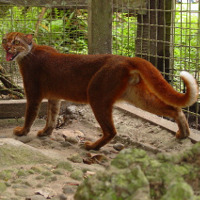 |
Golden Cat of Borneo |
|
He is a wild animal |
Origin |
Borneo | |
Translation |
Francis Vandersteen |
| The possession of this animal is not authorized Royal Decree establishing the list of mammals not kept for production purposes that may be kept (M.B. 24.08.2009) |
| The Golden Cat of Borneo is a feline of the genus Pardofelis, endemic to the island of Borneo. About the size of a domestic cat, it resembles Temminck's cat, but has a uniform red or gray coat and a long tail. It is one of the least known felines: no data on its reproduction or lifestyle have ever been collected. It is assumed that it inhabits primary forests and hunts small animals such as rodents. Little known to local populations, this feline has long been known only through skins and skulls held by natural history museums. Biometric and morphological data on the Bay Cat are based almost entirely on a single specimen captured by chance in 1992, and the first photograph of this feline in the wild dates back to 1998. Since then, the scientific community has had access to some thirty photographs taken in the 2000s using camera traps. Classified as "Endangered" by the IUCN, the Bay Cat is protected throughout its range. The main threats to the species are poaching and deforestation. It is included in the Bornean Wild Cat and Clouded Leopard Project, whose aim is to provide behavioral and ecological data on Bornean cats, and should eventually benefit from a protection plan. The bay cat's coat comes in two different colors: red and gray. Although the initial hypothesis favored the reddish rather than the gray form, research has shown that there is no dominant phase and both colors can be found indifferently in a group of individuals. Some traces of spots can be seen on the body. The belly is lighter, slightly mottled. The underside of the tail is characterized by a long, whitish mark extending from the base to the middle of the tail. The head is rounded. The underside of the ears, set fairly low on the skull, is dark gray with no white spot in the middle. A stripe runs from the outer side of each eye to the forehead, and faint stripes run horizontally across the cheeks. On the back of the skull, markings form the letter M. The dentition is characterized by a small upper first premolar, with a rounded head and a single root. The body with head measures 50 to 69 cm, while the tail reaches 35 to 43 cm. Total length is estimated at around 85 cm, and the height at the shoulder, close to that of the domestic cat, is 28 to 30 cm. The bay cat's weight is estimated at two to four kilos. Little is known about its behavior. It is reputedly ferocious and probably lives alone. It feeds on small mammals such as rats and mice, but also on insects, monkeys and birds. It is probably a scavenger at times, and may attack larger prey. It is thought to hunt on the ground. It is apparently diurnal, with peak activity at dawn. |






 English (United Kingdom)
English (United Kingdom)